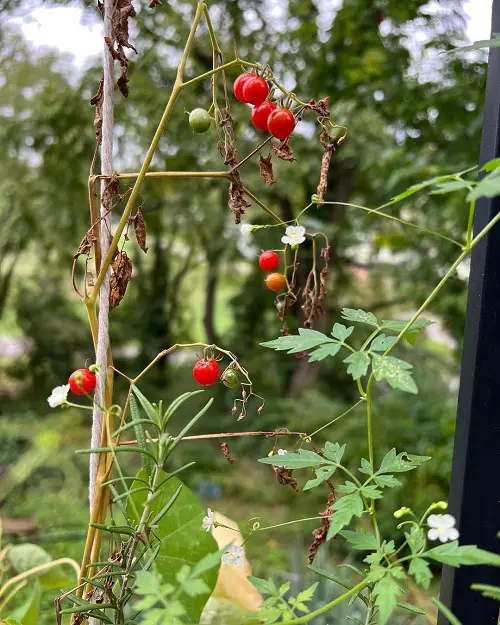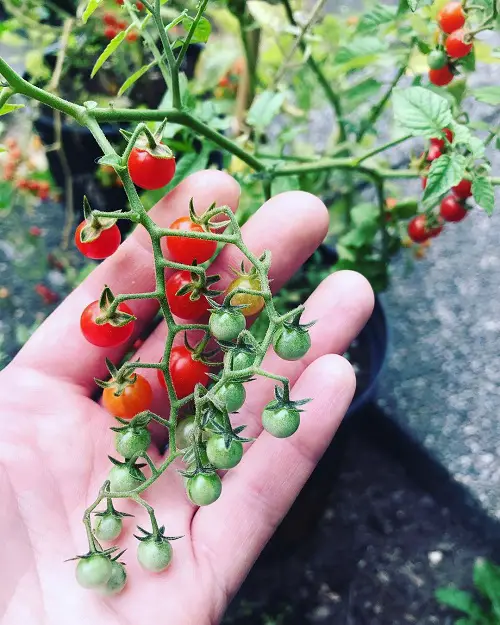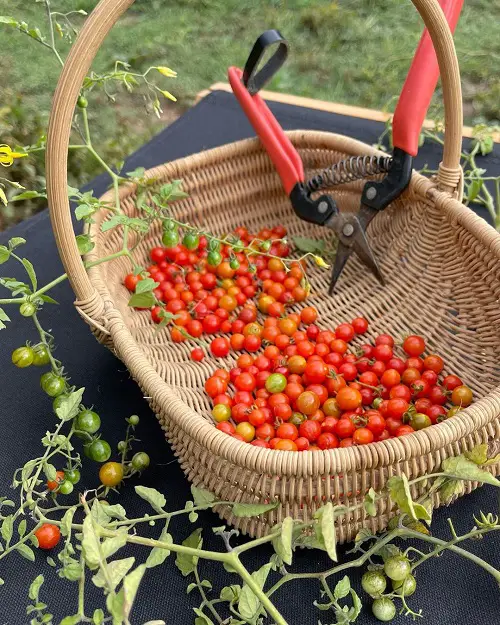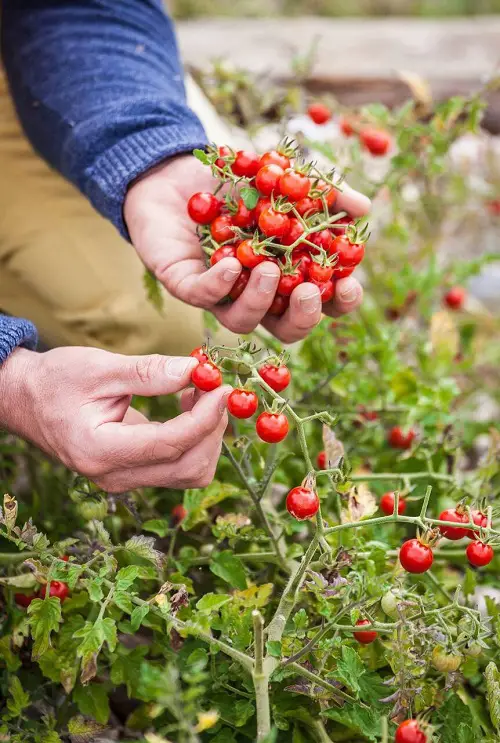Are you tired of the same old boring tomatoes in your garden? Well, get ready to learn How to Grow Spoon Tomatoes!
Spoon Tomatoes are not only visually stunning with their spoon-shaped fruits, but they also offer a delicious and juicy taste that will leave your taste buds wanting more.
Learn Growing Heirloom Tomatoes In Pots
Spoon Tomato Plant Information
The world’s smallest tomato is the ‘Spoon Tomato.’ This tiny tomato was developed by the horticulture team at the University of Florida. It is a hybrid of cherry and grape tomatoes.
It is incredibly small, measuring just 1/3 of an inch in diameter, and has a sweet and juicy flavor. The plants are productive and produce clusters of these tiny tomatoes and grow to a height of 3-4 feet.
They are perfect for adding a pop of color to salads, and their size makes them ideal for snacking. Spoon Tomatoes have become popular among gardeners and can be found in seed catalogs and online retailers.
Botanical Name: Solanum pimpinellifolium ‘Spoon Tomato’
USDA Zones: 4-11
Learn How to Grow So Many Tomatoes in So Little Space
Spoon Tomato Plant Size
The Spoon Tomato plant is a unique variety of tomatoes that is known for its small and compact size. The plant typically reaches a height of around 3 to 4 feet (0.9 to 1.2 meters) when fully grown, making it an ideal choice for gardeners with limited space. Despite its small size, the Spoon Tomato plant is known to produce an abundant harvest of delicious and sweet-tasting tomatoes.
The fruit of the Spoon Tomato plant is typically small in size, with a diameter of around 1 to 2 inches (2.5 to 5 centimeters) and a round, slightly flattened shape that resembles a spoon.
Propagating Spoon Tomatoes

Spoon Tomatoes can be grown both indoors and outdoors.
By Stem Cuttings
- Take 5-6 inches-long cuttings of a mature plant, at least two leaf nodes, typically during the summer months.
- Remove the lower leaves place the cutting in a pot filled with potting soil and lightly press the soil around the stem.
- Water the soil and keep it moist.
- After a few weeks, the cutting will produce roots. At this point, you can transplant the cutting into a larger pot or into your garden.
By Seeds
- Spoon Tomatoes seeds can be planted directly outdoors when the soil has reached the correct temperature.
- Plant the seeds and cover them lightly with soil. Water the soil and keep it moist.
- After a few weeks, the seeds will sprout, and you can then transplant them into the garden.
Whichever method you choose, it is important to make sure the soil is kept moist and that the plants are in a warm and sunny location. With proper care, you should have a thriving crop of Spoon Tomatoes in no time!
Requirements to Grow Spoon Tomatoes

Sunlight
Spoon Tomatoes need at least 6-8 hours of direct sunlight each day. They also need full sun, which means that the sunlight should reach all areas of the plant, including the leaves and the fruit.
If the sun exposure is limited, try to place the plants near windows or other reflective surfaces to help them get the sunlight they need. With adequate sunlight and proper care, Spoon Tomatoes should start to bear fruit in about two months.
Soil
These little tomatoes require well-draining, nutrient-rich soil. A soil pH between 6.0 and 6.8 is ideal, and compost should be added to the soil to improve aeration and drainage.
If possible, test the soil before planting, as this will help ensure that the right nutrients are added to the soil.
The soil should also be lightly tilled to a depth of 8-10 inches to create a loose, crumbly texture that will allow for proper root development. After planting, a layer of mulch should be added to help retain moisture, reduce weeds, and protect the soil from extreme temperatures.
Watering
When watering, it is important to avoid over-watering or under-watering Spoon Tomatoes. For best results, try to water in the morning or early evening when temperatures are cooler. This will help prevent the leaves from burning in the hot sun.
In general, Spoon Tomatoes need about an inch of water each week. When first planting the seeds, water them thoroughly. As the plants grow, reduce the amount of water, but make sure they continue to receive at least an inch per week.
When watering Spoon Tomatoes, water the soil directly at the base of the plant instead of the leaves. This will help keep the leaves dry and prevent fungal diseases. Also, try to use a watering can or hose to disperse the water evenly throughout the soil.
Temperature
The ideal temperature for growing Spoon Tomatoes is 70-85°F (21-28°C). If the temperature is too high, it can stress the plants and reduce yields.
Temperatures above 95°F (35°C) can cause the tomatoes to become sunburned and stop producing.
Spoon Tomato Care

Fertilizer
Spoon Tomatoes are heavy feeders and require regular fertilization to grow healthy and produce fruit. The best time to fertilize your cherry tomatoes is when the plants are actively growing. For most parts of the country, this will be in the early spring and again in mid-summer.
Use a balanced fertilizer or one that is high in phosphorus and potassium to encourage fruit production. Dilute it to 1/2 of its strength and use it every 2-3 weeks to encourage fruit production.
Support
Stakes are an easy way to provide extra support for Spoon Tomatoes. Make sure the stakes are at least four feet tall, and place them into the ground at least a foot away from the plant.
You can use plastic or bamboo poles or wooden sticks for the purpose.
Here are DIY Tomato Cage, Trellis & Stake Ideas
Pests and Diseases
Common Pests:
- Aphids: These small, soft-bodied insects suck the sap from the stems and leaves of Spoon Tomatoes. They can also spread plant viruses.
- Tomato Hornworms: These large caterpillars eat foliage, stems, and tomatoes.
- Whiteflies: These small white insects feed on the underside of leaves and excrete a sticky substance called honeydew.
- Mites: These tiny arachnids suck the sap from the undersides of the leaves, causing yellowing and browning.
Common Diseases:
- Early Blight: This fungal disease causes dark spots to form on the leaves and stems of Spoon Tomatoes.
- Late Blight: This fungal disease causes brown spots to form on the leaves and stems.
- Fusarium Wilt: This fungal disease causes the leaves to wilt and die.
- Verticillium Wilt: This fungal disease causes the leaves to turn yellow, wilt, and die.
Harvesting Spoon Tomatoes

Most Spoon Tomatoes are ready to be harvested when they turn bright red in color. Cut the entire stem that is carrying them. You can collect 5-6 ripe ones in a spoon!
After cutting the stem, it is important to handle the tomatoes carefully to avoid bruising and damage. Once harvested, you can store them in a cool, dry place until ready for use.
Is Spoon Tomato Determinate or Indeterminate?
Spoon Tomato is an indeterminate plant, which means it will continue to produce fruit throughout the growing season. It is a 60- 70-day indeterminate tomato and an excellent choice for anyone who wants to grow their own tomatoes but doesn’t have a lot of space.
It’s a small and productive plant that produces delicious fruit and is easy to care for. So why not give it a try?




